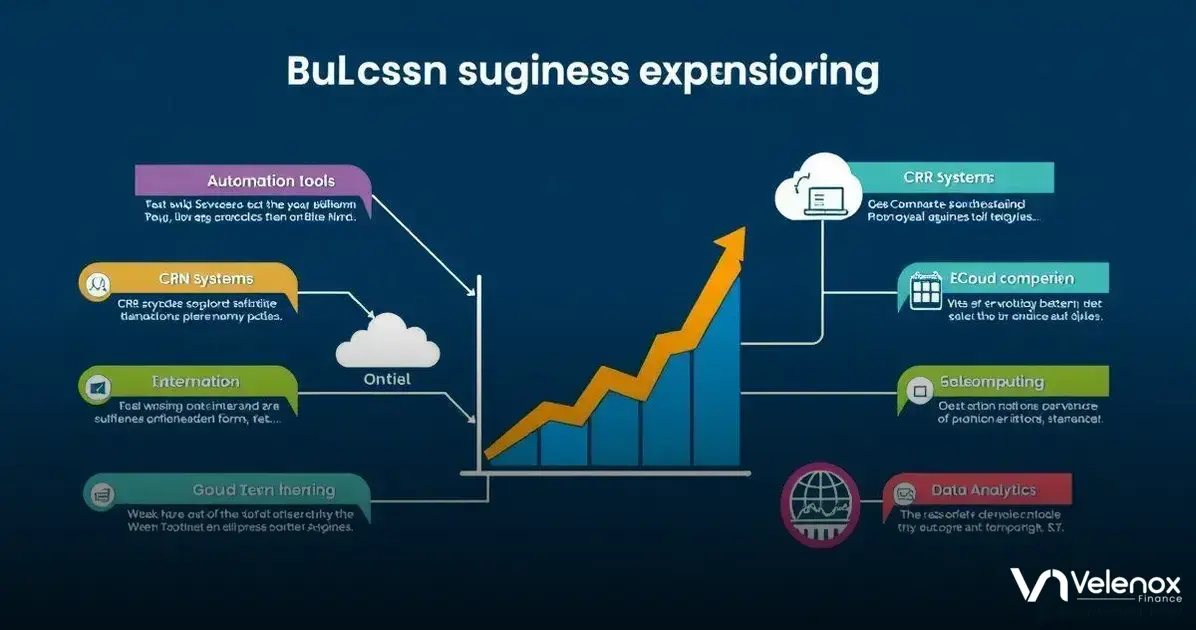How to scale a business is a question many entrepreneurs ask. In today’s competitive market, growth is essential for survival.
Successful scaling involves not only increasing revenue but also enhancing operations and expanding your market reach.
Understanding Business Scaling Concepts
Understanding business scaling concepts is essential for entrepreneurs aiming to grow their companies.
Scaling a business means not only increasing sales but also enhancing operations to handle demand effectively.
To scale successfully, business owners need to recognize the difference between growth and scaling.
Growth vs. Scaling
Growth typically refers to increasing revenue and product sales.
Scaling, on the other hand, focuses on creating systems and processes that support substantial growth without a proportional rise in costs.
This means that as your company expands, it should not only gain more customers but also become more efficient.
Key Principles of Scaling
There are several key principles that can help guide your scaling journey:
- Adaptability: Be prepared to pivot your strategies according to market changes.
- Efficiency: Streamline operations to maximize productivity.
- Customer Focus: Always prioritize providing value to your customers as your business grows.
Understanding these principles can position you for a successful scaling process.
Moreover, awareness of your business’s core competencies helps in leveraging strengths while addressing any weaknesses.
Importance of a Scalable Business Model
A scalable business model is crucial for sustained growth. It allows your business to handle increased sales without significantly raising costs.
This entails developing infrastructure capable of supporting larger volumes of work, whether through automation, outsourcing, or improved resource management.
In summary, mastering the fundamentals of business scaling is a critical step.
With these concepts in mind, you can effectively navigate the complexities of growing your business.
Identifying Growth Opportunities
Identifying growth opportunities is crucial for any business looking to scale.
By recognizing where your business can expand, you can create a roadmap for sustainable growth.
Market Research
The first step in identifying growth opportunities is conducting thorough market research.
This means looking at your competitors, current trends, and customer feedback.
Understand who your target audience is and what they need. This can help you tailor your offerings to meet demand.
Customer Insights
Engaging with your customers can provide valuable insights.
Surveys, feedback forms, and direct conversations are vital for understanding your customer’s needs and preferences.
Knowing what they like or dislike about your product can guide your strategies for improvement.
Identifying New Markets
Expansion into new markets can significantly boost growth.
This might involve entering a new geographic area or catering to a different demographic.
Evaluate potential markets carefully to determine where your product or service can fit well.
Product Development
Another way to identify growth opportunities is through product development.
Assess your current offerings and think about how you can enhance or diversify them.
New features, variations, or entirely new products based on consumer demand can lead to increased sales.
Partnership Opportunities
Consider forming partnerships with other businesses. Strategic alliances can open doors to new customer bases, resources, and expertise.
Collaborating with complementary businesses can create mutually beneficial opportunities.
By focusing on these strategies for identifying growth opportunities, businesses can position themselves to expand efficiently and effectively
. Always stay creative and open-minded to discover what areas offer the best potential for scaling.
Developing a Scalable Business Model

Developing a scalable business model is essential for growth.
A scalable model allows your business to increase revenue without a corresponding rise in costs. Here are some key aspects to consider:
1. Clear Value Proposition
Your business model should have a clear value proposition.
This explains what makes your product or service unique and why customers should choose it over others. Understanding this helps attract the right audience.
2. Efficient Processes
To scale effectively, your processes need to be efficient. Streamline operations to reduce waste and speed up workflows.
This allows you to handle more customers without sacrificing quality.
3. Technology Integration
Leveraging technology is crucial. Use tools and software that automate repetitive tasks, manage customer relationships, and assist with inventory.
Technology can enhance productivity and help you scale faster.
4. Flexible Financial Structure
A flexible financial structure supports growth. Consider various funding options, like loans or investments, that can provide capital when needed.
Ensure your revenue model aligns with your scaling goals.
5. Building the Right Team
Your team’s skill set plays a vital role in scaling. Hire employees who can adapt and grow with the business.
Invest in training to equip your team with the necessary skills to face new challenges.
6. Customer-Centric Approach
Always keep your customers at the heart of your business model. Understand their needs and gather feedback to improve your offerings.
A loyal customer base fuels growth and provides a solid foundation for scaling.
By focusing on these elements, you will build a robust business model that can handle growth efficiently.
A scalable model not only enhances profitability but also prepares your business for future opportunities.
Effective Marketing Strategies for Scaling
Effective marketing strategies for scaling your business are crucial as you grow.
Here are several key tactics that can help you reach a broader audience and drive sales:
1. Seek Out Digital Marketing
With the rise of the internet, digital marketing is a powerful tool for reaching potential customers.
Use social media platforms like Facebook, Instagram, and LinkedIn to connect with your audience directly.
Create engaging content that resonates with your target market.
2. Leverage SEO
Search Engine Optimization (SEO) is critical for increasing your online visibility.
Optimize your website and content for relevant keywords, making it easier for customers to find you through search engines.
This can lead to more traffic and potential sales.
3. Create Targeted Advertising
Invest in targeted online advertising, such as Google Ads or social media ads.
These ads can reach specific demographics and interests, ensuring that your marketing efforts are focused on the right audience.
4. Utilize Email Marketing
Email marketing remains an effective strategy for nurturing customer relationships.
Send out regular newsletters with updates, promotions, and helpful content to keep your audience engaged.
Personalize your emails to better connect with your recipients.
5. Offer Promotions and Discounts
Attract new customers by offering promotions and discounts.
Limited-time offers can create a sense of urgency, encouraging potential customers to make a purchase. It also shows your willingness to provide value.
6. Measure and Analyze Performance
Regularly measure the effectiveness of your marketing strategies. Use analytical tools to track website traffic, conversion rates, and customer engagement.
This data will help you refine your marketing efforts and focus on what works best.
7. Collaborate with Influencers
Partnering with influencers in your industry can expand your reach considerably.
Influencers have established credibility, and their endorsement can introduce your brand to a wider audience.
By implementing these marketing strategies, you can effectively scale your business and reach new heights of success.
Continuously adapting and improving your marketing efforts will lead to sustainable growth.
Building a Reliable Team for Growth
Building a reliable team for growth is one of the most important steps in scaling a business.
The right team can drive your company forward and help achieve long-term success.
1. Hire for Skills and Culture Fit
When recruiting team members, look for both skills and a culture fit.
Your employees should have the expertise needed for their roles, but they should also align with your company values.
A strong cultural fit promotes teamwork and reduces turnover.
2. Provide Ongoing Training
Investing in your employees through ongoing training is essential.
Regular training ensures that your team stays updated with industry trends and improves their skill sets.
Consider workshops, online courses, or coaching sessions to enhance their capabilities.
3. Foster a Collaborative Environment
Create a workplace where collaboration is encouraged. A collaborative culture allows team members to share ideas and support each other.
Use tools like project management software and regular team meetings to facilitate communication.
4. Set Clear Goals and Expectations
Establishing clear goals and expectations enables your team to understand what is required of them.
Use SMART (Specific, Measurable, Achievable, Relevant, Time-bound) goals to guide their efforts and keep everyone aligned.
5. Recognize and Reward Achievements
Recognizing hard work and rewarding achievements can boost morale.
Celebrate small wins as well as big milestones. This recognition fosters a positive work environment and motivates your team to continue performing at high levels.
6. Encourage Feedback and Open Communication
Encourage employees to give feedback and communicate openly. This practice helps identify issues quickly and allows for improvements.
An open-door policy can create a sense of trust and make team members feel valued.
7. Lead by Example
Your leadership style sets the tone for the team. Lead by example and embody the values you want your team to adopt.
When team members see commitment and hard work from leaders, they are more likely to mirror that behavior.
By focusing on these aspects, you can build a strong and reliable team that is prepared to support your business growth.
A cohesive and motivated team is a powerful asset in reaching your scaling goals.
Leveraging Technology for Business Expansion

Leveraging technology for business expansion is a key strategy for scaling successfully.
As technology evolves, utilizing the right tools can significantly enhance your operational efficiency and market reach.
1. Automation Tools
Implementing automation tools can save time and reduce errors.
By automating routine tasks like invoicing, data entry, or customer follow-ups, your team can focus on higher-level strategic work.
This makes your operations more efficient and allows for seamless scaling.
2. Customer Relationship Management (CRM) Systems
Investing in a CRM system helps manage customer interactions and data effectively.
This technology allows businesses to track leads, follow up on sales opportunities, and maintain strong customer relationships.
A good CRM can boost sales and improve customer satisfaction.
3. E-Commerce Platforms
If you are selling products, consider using e-commerce platforms to reach a wider audience.
These platforms can handle transactions, inventory management, and shipping logistics. They also provide valuable insights on customer behavior through analytics.
4. Cloud Computing
Utilize cloud computing to store and manage data. Cloud services enable remote access to essential information, which can enhance collaboration among team members.
This is particularly helpful for businesses with employees working from different locations.
5. Data Analytics
Leverage data analytics tools to gain insights into your business performance.
By analyzing business data, you can identify trends, understand customer preferences, and make informed decisions.
This allows for strategic planning and effective resource allocation.
6. Social Media Management Tools
Use social media management tools to streamline your marketing efforts.
These tools can help schedule posts, analyze engagement, and manage customer interactions across various platforms.
A strong social media presence can enhance brand visibility and attract new customers.
7. Cybersecurity Measures
As you expand, investing in cybersecurity becomes critical. Protecting your data and customers’ information is essential for building trust.
Implement robust security measures to prevent data breaches and ensure business continuity.
By effectively leveraging technology, businesses can position themselves for growth and stay competitive in an ever-changing landscape.
Embracing these tools allows for smoother expansion and better service to customers.
Financial Strategies for Scaling
Implementing effective financial strategies for scaling your business is crucial for sustained growth. Here are some key strategies to consider:
1. Budgeting and Forecasting
Accurate budgeting and forecasting allow you to allocate resources wisely. Create a detailed budget that reflects your expected income and expenses.
Regularly review and adapt your budget based on actual performance and changing business needs.
2. Cost Management
Reducing unnecessary costs can free up funds for expansion. Review all expenses and identify areas where you can cut back without sacrificing quality or service.
This includes renegotiating supplier contracts or outsourcing non-core functions.
3. Diversifying Revenue Streams
Consider diversifying your revenue streams to protect against market fluctuations.
Explore new product lines or services, expand into new markets, or develop alternative sales channels.
This strategy helps create stability and increases growth potential.
4. Securing Funding
As your business grows, you may need additional funding. Look into options like small business loans, angel investors, or venture capital.
Be prepared with a solid business plan and financial projections to attract potential investors.
5. Cash Flow Management
Effective cash flow management ensures you have enough cash on hand to cover day-to-day operations.
Monitor your cash flow regularly and implement strategies to speed up collections from customers while extending payment terms with suppliers when possible.
6. Performance Metrics
Utilize key performance indicators (KPIs) to measure financial performance.
Metrics such as gross profit margin, return on investment (ROI), and customer acquisition cost offer valuable insights into your business’s financial performance.
These indicators also help assess growth potential and guide strategic decision-making.
7. Invest in Growth
Reinvest profits back into the business to fuel further growth. This could involve upgrading technology, hiring additional staff, or expanding marketing efforts.
Making strategic investments ensures you’re better positioned for scaling.
By employing these financial strategies, you can effectively manage your resources and support the growth of your business.
A sound financial plan is essential for long-term success as you scale.
Measuring Success and Adapting Strategies
Measuring success and adapting strategies is crucial for ensuring your business continues to grow effectively.
This involves evaluating how well your operations align with your goals and making necessary adjustments.
1. Define Key Performance Indicators (KPIs)
Establish clear KPIs to assess performance. These can include sales growth, customer acquisition cost, customer retention rates, and profit margins.
KPIs provide a tangible way to track your business’s success.
2. Regular Performance Reviews
Conduct regular performance reviews to analyze progress towards your goals. Schedule these reviews quarterly or biannually to identify trends and areas for improvement.
Use this time to assess what strategies are working and which need adjustment.
3. Customer Feedback
Gather input from customers to understand their experiences and satisfaction.
Surveys, reviews, and direct feedback can offer valuable insights into how your products or services are perceived. Utilize this information to refine your offerings.
4. Financial Analysis
Perform financial analyses to evaluate cost management and revenue generation. Look at profit margins and cash flow to ensure your business is financially healthy.
This analysis can help highlight areas that need more focus or investment.
5. Benchmarking
Compare your performance against industry standards or your competitors.
Benchmarking can reveal how you stack up against the market and help identify best practices that can be adopted for your business.
6. Flexibility in Strategy
Be prepared to adapt your strategies based on what your evaluations show.
The business environment is constantly changing, so remaining flexible can help you seize new opportunities and address challenges quickly.
7. Continuous Learning
Engage in continuous learning by keeping up with industry trends and innovations. Attend workshops, seminars, and networking events.
Staying informed can provide new ideas and approaches for scaling your business effectively.
By measuring success accurately and adapting strategies accordingly, businesses can remain agile and competitive in their industries.
This proactive approach ensures that you are always moving toward your goals.
In Summary: Unlocking Growth Strategies for Success
Scaling a business requires a multifaceted approach that involves understanding key concepts, identifying growth opportunities, and developing a scalable business model.
Effective marketing strategies, building a reliable team, and leveraging technology are crucial components for expansion.
Financial strategies should support your growth efforts while ensuring sustainability.
Moreover, measuring success and adapting strategies based on performance data lays the foundation for continuous improvement.
By implementing these strategies, businesses can achieve their scaling goals and thrive in a competitive landscape.
Embrace these methods to unlock the full potential of your business.





